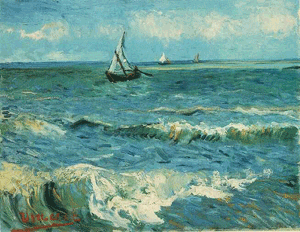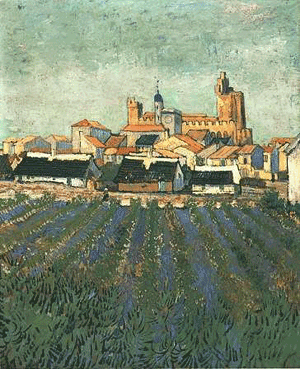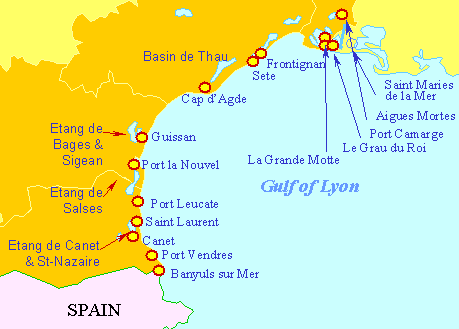
![]()
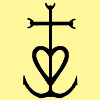
![]() (population
2,000), An overgrown village and the tourist resort, is
a port on the Mediterranean
coast close to the mouth of the Petit
Rhône. It lies about 45 km to the southwest of
Arles.
(population
2,000), An overgrown village and the tourist resort, is
a port on the Mediterranean
coast close to the mouth of the Petit
Rhône. It lies about 45 km to the southwest of
Arles.
The Camargue in general and Saintes-Maries-de-la-Mer in particular are associated with the Roma (Gypsies, French Gitans). In medieval times this was the site of the a Roma pilgrimage made each year to venerate Saint Sara, It still is today.
According to local legend three biblical Marys arrived here across the Mediterranean Sea - hence the name: Saintes-Maries-de-la-Mer means "Three Marys of the Sea". According to some they were Mary, mother of Jesus, Mary, sister of Lazarus, and Mary Magdalene. This ancient tradition is something of an an embarrassment to the Roman Catholic Church especially the idea that Mary Magdalene, supposedly the wife or concubine of Jesus, arrived with their infant daughter Sara. (This story keeps resurfacing, most recently in the 1970 in "The Holy Blood and the Holy Grail" and in the twenty first century in Dan Browne's "The Da Vinci Code". (A Church chronicler named Raynaldus mentions in the thirteenth century that the Cathars of the Languedoc regarded Mary Magdelene as Jesus' concubine)

![]()

![]() The
three Marys are sometimes represented as Mary Jacobé
(the sister of Mary, Jesus' mother - a person invented by
the Roman Church to explain biblical mentions of other children
born of the "Virgin" Mary); Mary Salomé
(the mother of Apostles James the Greater and John); and
Mary-Magdalene. Sara is often explained away as a servant.
Either way the three Mary were supposedly expelled from
Jerusalem around the year AD 40. They were shipped off,
along with Lazarus, Martha, Maximin, and Sidon, on a boat
without sails, oars or provisions. According to the story
Sara was not allowed on board, but one of the Marys threw
her coat onto the waters and it miraculously turned a raft,
allowing Sara to join the other sea farers. Their boat eventually
landed near Les Saintes-Maries-de-la-Mer. The Marys - and
Sara - lived out the rest of their days in the Camargue,
where their graves became a places of pilgrimage, especially
for gypsies - Sara became the patron saint of the Gypsies.
The
three Marys are sometimes represented as Mary Jacobé
(the sister of Mary, Jesus' mother - a person invented by
the Roman Church to explain biblical mentions of other children
born of the "Virgin" Mary); Mary Salomé
(the mother of Apostles James the Greater and John); and
Mary-Magdalene. Sara is often explained away as a servant.
Either way the three Mary were supposedly expelled from
Jerusalem around the year AD 40. They were shipped off,
along with Lazarus, Martha, Maximin, and Sidon, on a boat
without sails, oars or provisions. According to the story
Sara was not allowed on board, but one of the Marys threw
her coat onto the waters and it miraculously turned a raft,
allowing Sara to join the other sea farers. Their boat eventually
landed near Les Saintes-Maries-de-la-Mer. The Marys - and
Sara - lived out the rest of their days in the Camargue,
where their graves became a places of pilgrimage, especially
for gypsies - Sara became the patron saint of the Gypsies.
Click here for more on St Sarah (or Sara), St Martha, St Mary Magdalene, St Mary Salome, St Mary Jacob, Lazarus, Maximus and Sidonius 
In French Gypsies are called Gitans (from Spanish gitano, short form of egiptano (Egyptian) - the same error about their origins underlies the English word "gypsy"). The Gitan pilgrimage takes place in Les Saintes-Maries-de-la-Mer on 24 and 25 May to celebrate Mary Jacobé. A second pilgrimage celebrating Mary Salomé takes place on the Sunday closest to the 22 October. During these pilgrimages, the Gitan traditions mix with Gardian traditions.
Like almost all places with strong Christian traditions, this one previously had a strong pagan religious tradition - an oppidum near the village and the Camargue in general were once dedicated to Ra, the Egyption sun god.

![]() An important pilgrim route, the Via Tolosana (marked in blue on the right) led through Arles, St-Gilles, Saint-Guilhem-le-Désert and Toulouse and crossed the Pyrenees to join other routes at Puenta-la-Reina, thence to Santiago along the Via Compostelana to Santiago de Compostela.
An important pilgrim route, the Via Tolosana (marked in blue on the right) led through Arles, St-Gilles, Saint-Guilhem-le-Désert and Toulouse and crossed the Pyrenees to join other routes at Puenta-la-Reina, thence to Santiago along the Via Compostelana to Santiago de Compostela.
Another route, the Regordane (marked in green), led from Le Puy-en-Velay to St-Gilles, by way of the Cévennes, Alès and Nîmes. Some pilgrims came only as far as St-Gilles, the fourth most important pilgimage destination in Europe. Others went on to Santiago de Compostela along the Via Tolosana possibly taking a detour to Saintes-Maries-de-la-Mer (While Compostela claimed the relics of St-James, Saintes-Maries-de-la-Mer claimed the relics of his mother, Mary) |
|

![]() The
Camargue Cross is the emblem of the church of Saints Maries-de-la-Mer.
It is is composed of three emblems, an anchor, a cross,
and a heart. The upper cross is alleged to represent the
trident-shaped tool used by Gardiens - the arms are three-pronged.
The anchor symbolises the fishermen of the region.
The
Camargue Cross is the emblem of the church of Saints Maries-de-la-Mer.
It is is composed of three emblems, an anchor, a cross,
and a heart. The upper cross is alleged to represent the
trident-shaped tool used by Gardiens - the arms are three-pronged.
The anchor symbolises the fishermen of the region.
The church itself is of interest. Built near to the Petit Rhône it occupied a strategic position dominating the village and visible from 10km away. It was built between the ninth and eleventh centuries - a time when all coastal towns needed to defend themselves from seaward threats, ranging from pirate raids to full-scale invasions.
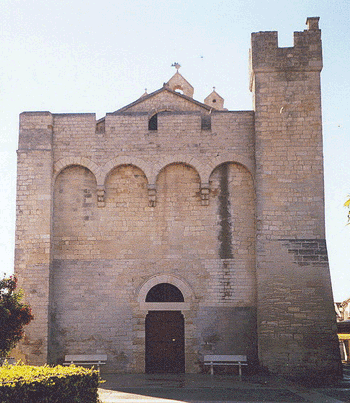
![]() The
church consists of a 15 metre high nave (nef) without side
aisles, its roof surrounded by a walkway - more of a castle
style chemin de ronde than an ecclesiastical ambulatory.
the walls are funished with crenellations (créneax)
and machiolations (mâchicoulis). the church clearly
served as a look-out tower (guet) as well as a defensible
possition. The walls feature loop holes (meurtrières,
or more specifically flechières). The Choir (chœur)
and apse (abside) are surmounted by an unusual hemispherical
keep (donjon) with a gard room (salle du corps) now innocently
described as a chapel "La Chapelle Haute". As
in all good defensible buildings, there is a well inside
the walls.
The
church consists of a 15 metre high nave (nef) without side
aisles, its roof surrounded by a walkway - more of a castle
style chemin de ronde than an ecclesiastical ambulatory.
the walls are funished with crenellations (créneax)
and machiolations (mâchicoulis). the church clearly
served as a look-out tower (guet) as well as a defensible
possition. The walls feature loop holes (meurtrières,
or more specifically flechières). The Choir (chœur)
and apse (abside) are surmounted by an unusual hemispherical
keep (donjon) with a gard room (salle du corps) now innocently
described as a chapel "La Chapelle Haute". As
in all good defensible buildings, there is a well inside
the walls.
Inside the church, the most obvious item of interest is a statue of Saint Sara placed in a crypt to the right of the alter. She is a rather improbable looking figure, dressed in a fetching pink outfit. The church claims to possess the relics of Sainte Marie Jacobé and Sainte Mary Salomé, discovered in in the crypt in 1448 and now housed in relicaries, having survived the French Revoltion during which they sustained some damaged. Also of interest is a non-Christian alter in the church dating from the fourth century BC.
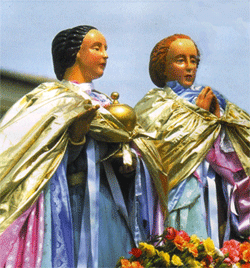
![]() Saintes-Maries-de-la-Mer
was once a pilgrimige site. It was popular
as a stopping point for pilgrims to St Jacques-de-Compostella,
where hundreds of thousands of pilgrims imagined (mistakenly)
that they were going to visit the remains of St James. They
believed that he had been miraculously been carried to the
Atlantic coast of Spain in a floating stone boat - also
without sails or oars. The popularity of Saintes-Maries-de-la-Mer
is therefore easily explicable. Pilgrims travelling to the
supposed burial place of St James would naturally stop off
on the way to visit the supposed burial place of his mother,
Mary Salomé.
Saintes-Maries-de-la-Mer
was once a pilgrimige site. It was popular
as a stopping point for pilgrims to St Jacques-de-Compostella,
where hundreds of thousands of pilgrims imagined (mistakenly)
that they were going to visit the remains of St James. They
believed that he had been miraculously been carried to the
Atlantic coast of Spain in a floating stone boat - also
without sails or oars. The popularity of Saintes-Maries-de-la-Mer
is therefore easily explicable. Pilgrims travelling to the
supposed burial place of St James would naturally stop off
on the way to visit the supposed burial place of his mother,
Mary Salomé.
On the 24th & 25th of May each year a number of activities take place at Saintes-Maries-de-la-Mer, celebrating the whole improbable story along with local culture and the arrival of Gitan pilgrims.
24th May
10:00 Mass to celebrate the pilgrimage
15:30 ceremony of bringing out and parading the relics of
the Marys
16:00 The statue of Sara is paraded and taken down to see
the sea
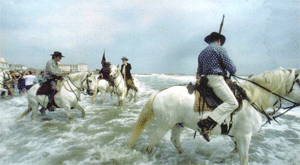
 25th
May
25th
May
10:00 Mass of Mary Jacobé and Mary Salomé
11:00 Procession to the beach to bless the sea, with the
statues of Mary Jacobé and Mary Salomé being
taken down to see the sea
15:00 Sara and the Marys all go home for their tea.
There is also a second "pilgrimage" on the sunday nearest to 22 October. This one also features the gardians, and the Marys, but not Sara or gitans.
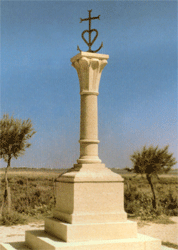
![]()

![]() 26th
May, this day commemorates Folco de Baroncelli, Marquis
de Baroncelli
26th
May, this day commemorates Folco de Baroncelli, Marquis
de Baroncelli
11:30 Bull running (abrivado and bandido) in the streets
of Saintes-Maries-de-la-Mer
12:00 Ceremonie at the tomb of Folco de Baroncelli
15:30 Festivities in the areana, including gardian games,
traditional dances and more bull running.

![]() Folco
de Baroncelli, Marquis of Barncelli, is a Camargue hero.
He was born in Aix in 1869, of an aristocratic florentine
family, and soon developed a love of bulls. He settled in
the Camargue in 1895, founding the Manando Santenco near
to Saintes-Maries-de-la-Mer. Living in relatively harsh
conditions he championed the Provencal / Occitan cause.
He codified the activities of the gardians and promoted
minority rights. It was de Baroncelli for example who won
for the gitans the right to honour Saint Sara publicly.
He as also resonsible for Camargue horse races. The Marquis
is also remembered for his humanity and generosity. his
festival is always well attended by gitans and gardians
among many others.
Folco
de Baroncelli, Marquis of Barncelli, is a Camargue hero.
He was born in Aix in 1869, of an aristocratic florentine
family, and soon developed a love of bulls. He settled in
the Camargue in 1895, founding the Manando Santenco near
to Saintes-Maries-de-la-Mer. Living in relatively harsh
conditions he championed the Provencal / Occitan cause.
He codified the activities of the gardians and promoted
minority rights. It was de Baroncelli for example who won
for the gitans the right to honour Saint Sara publicly.
He as also resonsible for Camargue horse races. The Marquis
is also remembered for his humanity and generosity. his
festival is always well attended by gitans and gardians
among many others.
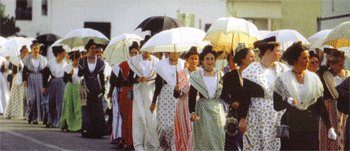
![]() In
1904 Frederic
Mistral the great champion of Occitan
and Occitania
founded a Festival of Virgins (
In
1904 Frederic
Mistral the great champion of Occitan
and Occitania
founded a Festival of Virgins ( Festo Vierginenco,
Festo Vierginenco,  Fête des Vierges). He organised the event himself
in Arles and expressed the wish that every Occitan town
should hold a similar Festo. Thanks largely to Folco de
Baroncelli, Marquis of Barncelli, Saintes-Maries-de-la-Mer
has retained this "new tradition". Each year les
cavaliers de la Nacioun Gardiano and the people of Arles
come to Saintes-Maries-de-la-Mer on the last Sunday in July
and young women walk around in traditional dress. This is
another excuse for bull running, gardian equestrian games,
traditional Occitan dancing, and other festivities.
Fête des Vierges). He organised the event himself
in Arles and expressed the wish that every Occitan town
should hold a similar Festo. Thanks largely to Folco de
Baroncelli, Marquis of Barncelli, Saintes-Maries-de-la-Mer
has retained this "new tradition". Each year les
cavaliers de la Nacioun Gardiano and the people of Arles
come to Saintes-Maries-de-la-Mer on the last Sunday in July
and young women walk around in traditional dress. This is
another excuse for bull running, gardian equestrian games,
traditional Occitan dancing, and other festivities.
Office du tourisme des Saintes-Maries-de-la-Mer:
5, avenue Van- Gogh, BP 34, 13732
Les Saintes-Marie-de-la-Mer. Phone: +33
(0)4 40 97 82 55.
Saintes-Maries-de-la-Mer Tourist Office - www.saintesmaries.com

![]() Click
here for more on Gardian
Marina at Saintes Maries
Click
here for more on Gardian
Marina at Saintes Maries ![]()
Click here for more on the Mediterranean
coast ![]()
Click here for Languedoc-Roussillon naturist
beaches ![]()
Click here for Languedoc-Roussillon marinas
![]()
Click here for more on the
Romanies and Saintes-Maries-de-la-Mer from http://www.greatriver.com
![]()
The present Languedoc
and Provence,
together represent the area covered by the ancient Roman's
first province outside Italy. The Camargue, lying in the
Rhone Delta, is positioned between the Languedoc and Provence.
For more on Provence and the Provençal town of Saintes-Maries-de-la-Mer,
click on the following link which will open a new window
to Beyond
the French Riviera www.beyond.fr ![]()
|
|
|
|
|
|
Extract from The Golden Legend, written around 1260 by a Dominican, the Blessed Jacobus de Voragne, later Archbishop of Genoa. This text from William Granger Ryan (translator), The Golden Legend, 2 vols, Princeton, 1993.. De Voragne has Mary arriving not in a small boat at Saintes-Maries-de-la-Mer but in a ship at Marseilles.
Mary Madelene in the Roman Prinince of Provence
Some fourteen years after the Lord's passion and ascention into heaven ... the disciples went off into the lands of the various nations and there sowed the word of the Lord. With the apostles at the time was one of Christ's seventy-two disciples, blessed Maximin, o whose care blessed Peter had entrusted Mary Magdalene. In the dispersion Maximin, Mary Magdalene, her brother Lazarus, her sister Martha, Martha's maid Martilla, blessed Cedonius, who was born blind but had been cured by the Lord, and many other Christians, were herded by the unbelievers into a ship without pilot or rudder and sent out to sea so that they might all be drowned, but by God's will they eventually landed at Marseilles. (vol 1. p 376)
Mary Madelene preaches
Then one day when Mary Magdalene was preaching ... (vol 1. p 377)
Mary Magdalene joins in the customary destruction and sequestration of non-Christian holy places
... they [Maximin, Mary and others] destroyed the temples of all the idols in the city of Marseilles and build churches to Christ [on the sites]. (vol 1, p 379)
Mary Magdalene retires to a local wilderness
At this time blessed Mary Magdalene, wishing to devote herself to heavenly contemplation, retired to an emply wilderness, and lived unknown for thirty years in a place made ready by the hands of angels. (vol 1. page 380)


